This is the 4th of four posts today.By mid-September, the Imperial Navy was ready to return to Orpheus. All four Lunar class cruisers, all six Dictator class carriers, two Dauntless class light cruisers and two Dread Argent class strike cruisers were formed into a powerful new fleet and dispatched to Orpheus. They would deliver an initial bomber strike, then, depending on results, potentially engage the Necrons at closer range, or least force them to burn through their ordnance. The Kaledon Hunters still held the surface of Orpheus-A II, so the Necron warships had nowhere to reload their torpedoes. If the alien force proved too powerful, the fleet would retreat, with the emphasis on preserving the carriers.
Battlefleet OrpheusLunar class Cruiser:
Agrippa, Holy Flame, Justicar, Righteous FuryDictator class Carrier:
Archon Kort, Bellator Stoicus, Ferrum Aeterna, Hammer of Justice, Rhadamanthine, Ultima PraetorDauntless class Light Cruiser:
Bloodhawk, DauntlessDread Argent class Strike Cruiser:
Eternal Defiance, Holy Execution
4x Thunderhawk Assault Transport
144x Starhawk-B Bomber
180x Fury Interceptor
4x Noctua Lander
7x Aquila Lander
Battlefleet Orpheus moved to a point midway between the Wolf 359 jump point and the planet, then launched all one hundred and forty-four Starhawks, escorted by one hundred and eighty furies and four Noctua class scouts. The strike wave massed over a hundred thousand tons. Only a single Noctua and a single Fury had sensors active. At one hundred million kilometres from Orpheus-A II, the Noctua detected a Necron Thokt class ship approaching. This was believed to be unarmed, so four Furies were detached and sent ahead to intercept.
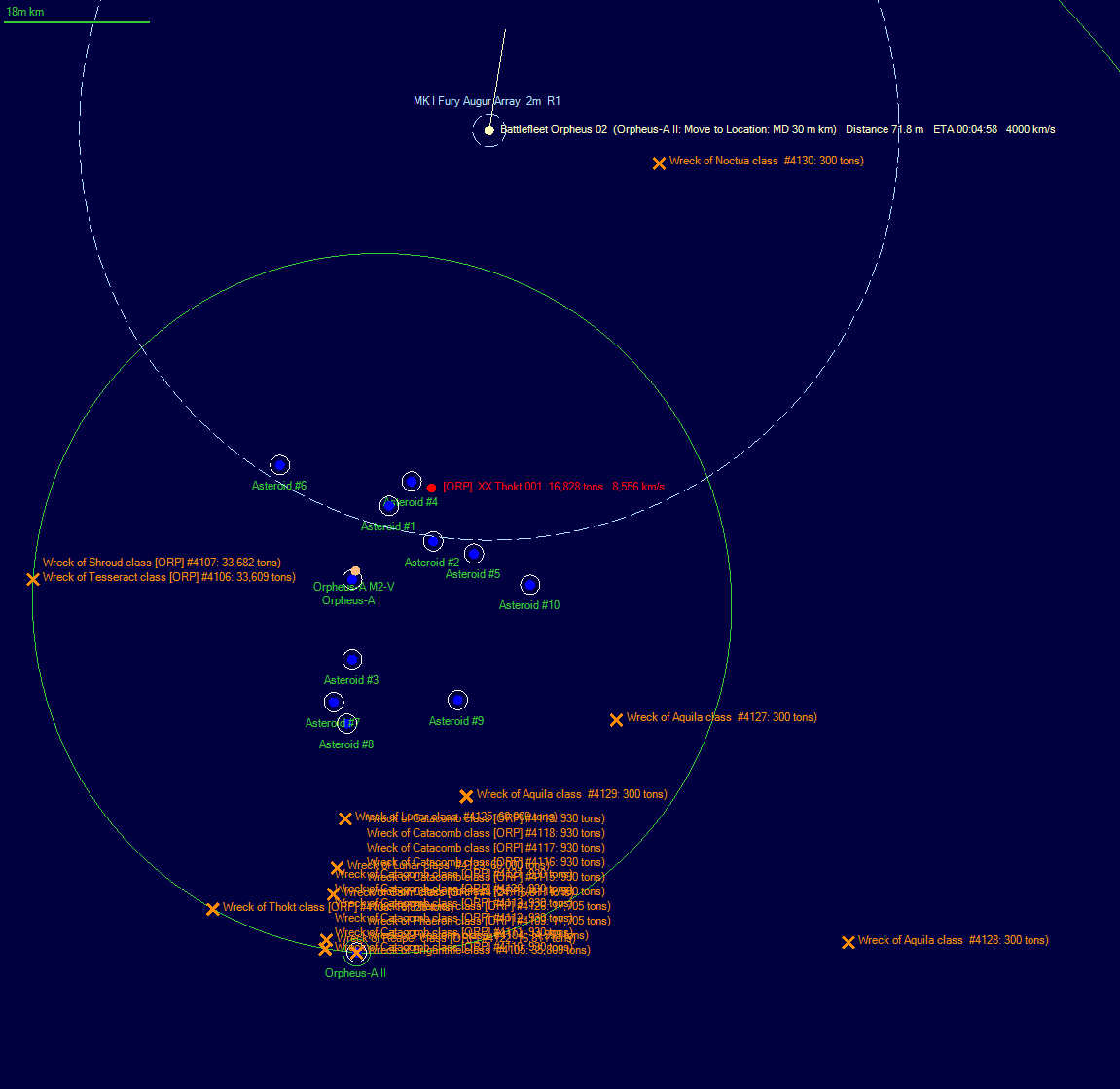
When the interceptors moved within fourteen million kilometres of the Necron ship, it reversed course and ran. The Furies had a 1440 km/s speed advantage so they pursued, keeping the Thokt away from the main strike wave. Suddenly, fifty-five million kilometres from the planet and less than nine from the Thokt, two of the Furies were struck by Necron torpedoes. The remaining pair reversed course and retreated, but were struck moments later. The Thokt reversed course and began advancing once again.
Six Starhawks were ordered to accelerate to full speed and launch their torpedoes against the Thokt, classified as a scout, as soon as their fire controls could achieve a lock. As they moved ahead of the rest of the strike wave, which was held back by the speed of the four Noctua landers, the Noctua detected the rest of the Necron fleet, comprising eleven destroyer-sized ships, two 33,000-ton Wraiths and the three 50,000-ton Thanatos class.
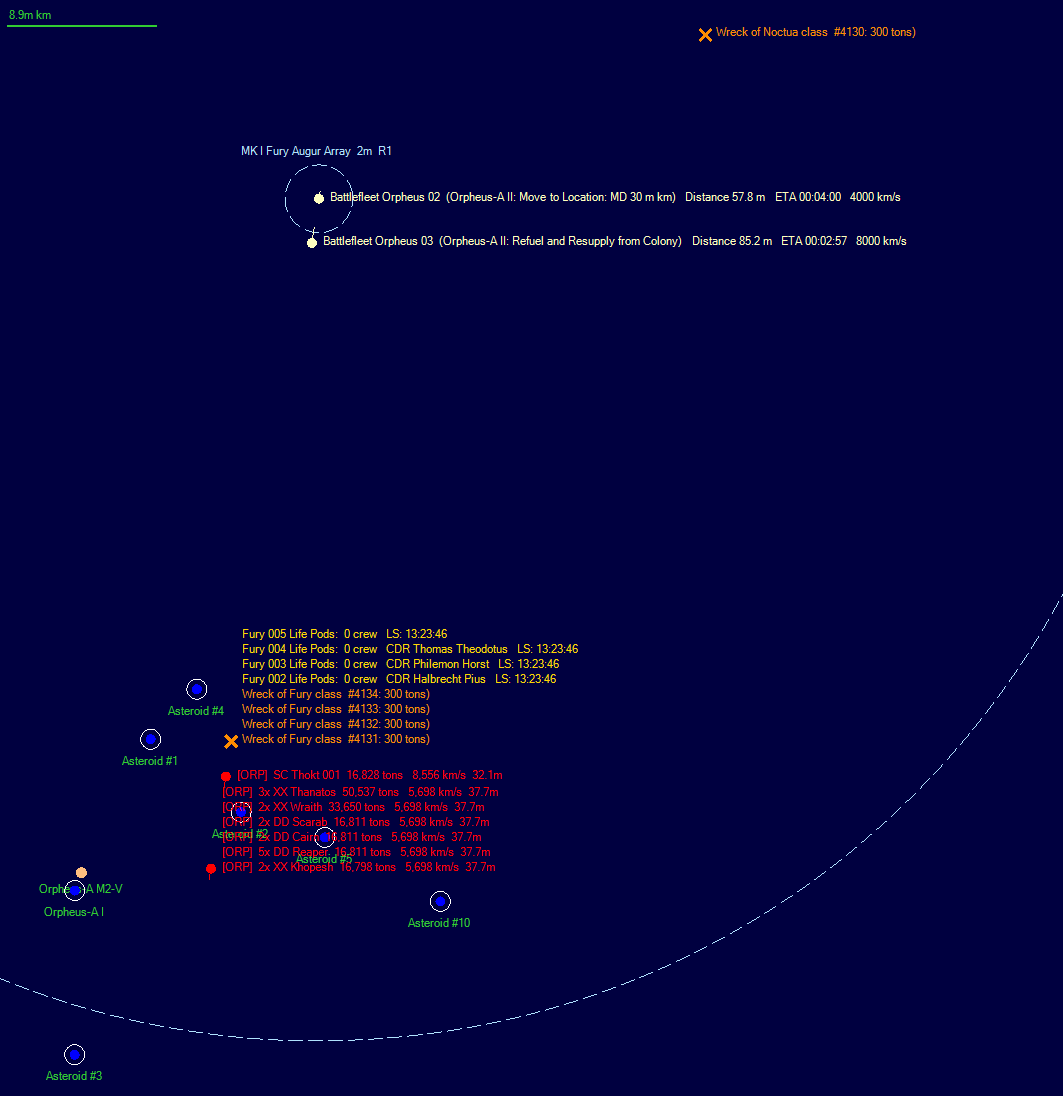
The leading Starhawks achieved a lock at twenty-six million kilometres and each launched its torpedo at the Thokt, before reversing course and heading for home. The rest of the Necron fleet was at thirty-two million kilometres. As the torpedoes had a speed of 22,500 km/s and the Thokt had a speed of 8556 km/s, along with superior electronic warfare capability, it was a difficult target. One torpedo was destroyed by some form of point defence system. Four of the remaining five, with an approximate twenty-seven percent chance to hit, missed the target. The last torpedo struck the Thokt amidships, penetrating the Necron armour with its strength-20 warhead and reducing the speed of the alien ship to 5700 km/s.
Learning from the attack on the scout, the rest of the strike wave targeted eighteen torpedoes each on six of the 16,800-ton destroyer-sized ships and thirty torpedoes on a 33,000-ton Wraith. The strike leader, Commander Apollo Galenus, was concerned about dispersal of the salvo, but the objectives of the strike were information-gathering for potential future attacks and forcing the expenditure of any defensive ordnance or decoys. The Imperial Navy could reload. The Necrons could not, at least as far as Inquisition Intelligence was aware. When the range fell to twenty-seven million kilometres, they launched. The bombers headed back for the carriers, along with two Noctua class landers trailing behind, while the Furies held the range open as long as they could while remaining with the other two Noctuas.
As the torpedo wave moved within a million kilometres of the Necron fleet, thirty-two strength-1 detonations were recorded, some hitting torpedoes but most striking decoys. Some of the Necron classes were equipped with the light torpedoes used to bombard the Raven Watch during the battle for Orpheus-A II, but they had yet to be observed closely enough to identify the launching ships. A further eighty detonations were detected over the next fifteen seconds, before thirty-six Necron torpedoes were detected closing on the Fury class interceptors. The Furies were ordered to leave the Noctua landers astern and retreat at full speed. Torpedoes from both sides closed on their targets simultaneously.
After almost a hundred more light torpedo detonations and forty-four impacts from energy-based point defence, the Imperial Navy torpedoes arrived at the Necron fleet. Fifty detonated their strength-20 warheads, twenty-one of which struck decoys. All seven targets were hit at least once and five suffered at least one armour penetration. One of the Reaper class destroyers was left dead in space and a Khopesh class was reduced to half speed. While the strike did not destroy any Necron ships, it absorbed a considerable number of light torpedoes, based on the assumption that only some of the defensive torpedoes hit their targets, forced the targets to expend their decoys and inflicted significant armour damage on several ships. Five seconds later, the Necron torpedoes arrived and eliminated the two closest Noctua. One of the two surviving Noctua activated its sensors so it could monitor the enemy fleet.
Lord-Captain Lucifer Varvanus, commanding Battlefleet Orpheus, ordered the wave of Fury class interceptors to charge the enemy fleet. While Varvanus held out little hope that they could penetrate the hostile defences, the Furies had a speed of 10,000 km/s and were difficult targets for the Necron torpedoes to hit, plus they possessed considerable point defence capability. The Necrons would have to expend irreplaceable torpedoes to eliminate them. Varvanus was also aware the Imperium was perhaps fifteen months away from developing Ion engine technology, partially because of advanced tech recovered from the alien sites in Sol and Alpha Centauri, at which point the interceptors would be replaced by a newer design. Therefore, from his cold, strategic perspective, they were an expendable resource in the quest for victory.
The damaged Khopesh and Thokt class ships reversed course away from the Imperial Navy attack craft. One of the Reapers was unable to move. The remaining Necron ships continued their advance. Eight minutes after the exchange of torpedoes, the Furies detected a new wave of thirty-six torpedoes, travelling at 32,000 km/s. On the assumption they were targeting the Noctua, the Furies used attacked the torpedoes as they passed, eliminating fourteen of them, along with almost sixty decoys. The rest passed by the Furies, destroyed both remaining Noctua and removing the Imperium sensor coverage.
Lord-Captain Varvanus ordered the Furies to set a course for Orpheus-A II, as they didn’t need to be able to see the Necron ships in order to absorb their torpedoes. Then he detached the carriers and took his four cruisers, two light cruisers and two strike cruisers toward the inner system. He could not fight the Necrons on equal terms, but he could wear them down and leave them open for the Starhawks to return with their short-ranged torpedoes. Five minutes later, the Furies encountered a wave of twenty-eight torpedoes and managed to shoot down twenty-three of them. The remaining five destroyed two Furies.
After a further eight minutes, the Furies detected a wave of thirty-six torpedoes, then ten seconds later the Necron fleet appeared at the edge of their two million kilometre sensor range. A hail of point defence fire greeted the torpedoes, killing over half, but another two Furies died. The enemy fleet continued to close, with the range dropping by fifteen thousand kilometres a second. Suddenly, at just over a million kilometres from the Necron fleet, a wave of one hundred and forty light torpedoes streaked in at 77,000 km/s. Despite heroic point defence efforts that destroyed over a quarter of the inbounds, Fourteen Furies were blown to pieces and another suffered armour damage.
Given the Necron light torpedoes had a ten second reload rate, then even if the Necrons maintained their reciprocal course and allowed the Furies to close to point-blank range, they would lose half of their strength before they arrived. If the Necrons reversed course, they would not make it into weapon range. Lord-Captain Varvanus was prepared to sacrifice the Furies and their crews for the good of the Imperium, but not without a commensurate gain. He ordered them to immediately reverse course and attempt to return to their carriers, if they could survive the follow-up salvos.
Ten seconds later, fourteen more interceptors were destroyed, then a dozen more. The retreating interceptors were hit with six waves in total, as the Necrons had waited until the Furies were well within range before launching the first attack. The ambush was extremely effective, especially as the Necrons had concealed the true strength of their light torpedo capability. Only ninety-four out of the original one hundred and eighty Furies were left in the strike wave and they had to endure further attacks from the Necron standard torpedoes. The Necron fleet continued to pursue the Furies, even as they disappeared from the sensors of the fleeing attack craft, which meant the rest of Battlefleet Orpheus was potentially in danger unless they stayed out of range. Unfortunately, the interceptors were down to half fuel so their carriers couldn’t retreat yet.
A follow-up attack by twenty-three standard torpedoes destroyed another Fury, but a subsequent wave of six was defeated by point defence. The size of the last wave, smaller than any previous attack in this or the previous battles, caused Lord-Captain Varvanus to consider if the Necrons really were running out of torpedoes, although it was also possible it was another Necron trick – suggesting weakness where none existed. That was the last Necron attack on the Furies and all the remaining attack craft landed without incident. Varvanus decided to hold Battlefleet Orpheus half-way between Orpheus-A II and the jump point, while the attack craft refuelled and the bombers loaded the older standard torpedoes. He dispatched an Aquila in an attempt to re-establish sensor contact with the main Necron fleet.
Eighty-seven Fury interceptors and four Noctua class landers had been lost and one hundred and forty-four torpedoes expended, in exchange for crippling one Necron ship, slowing another and inflicting armour damage on five more. The Necrons had also expended numerous torpedoes, which they presumably could not replace. In tactical terms it was undoubtably another defeat for the Imperial Navy, but strategically it was another step, albeit costly, toward inevitable victory.
The Aquila sent to locate the Necrons detected the Thokt class scout, still travelling at 5700 km/s, eighty million kilometres from Orpheus-A II, close to the location where the Furies were attacked by light torpedoes. The Thokt moved into close formation with the Aquila and began following it. Shortly thereafter, the Aquila detected the crippled Reaper at long range. Lord-Captain Varvanus ordered the Aquila to halt, while four Furies were launched with orders to attack the two Necron ships.
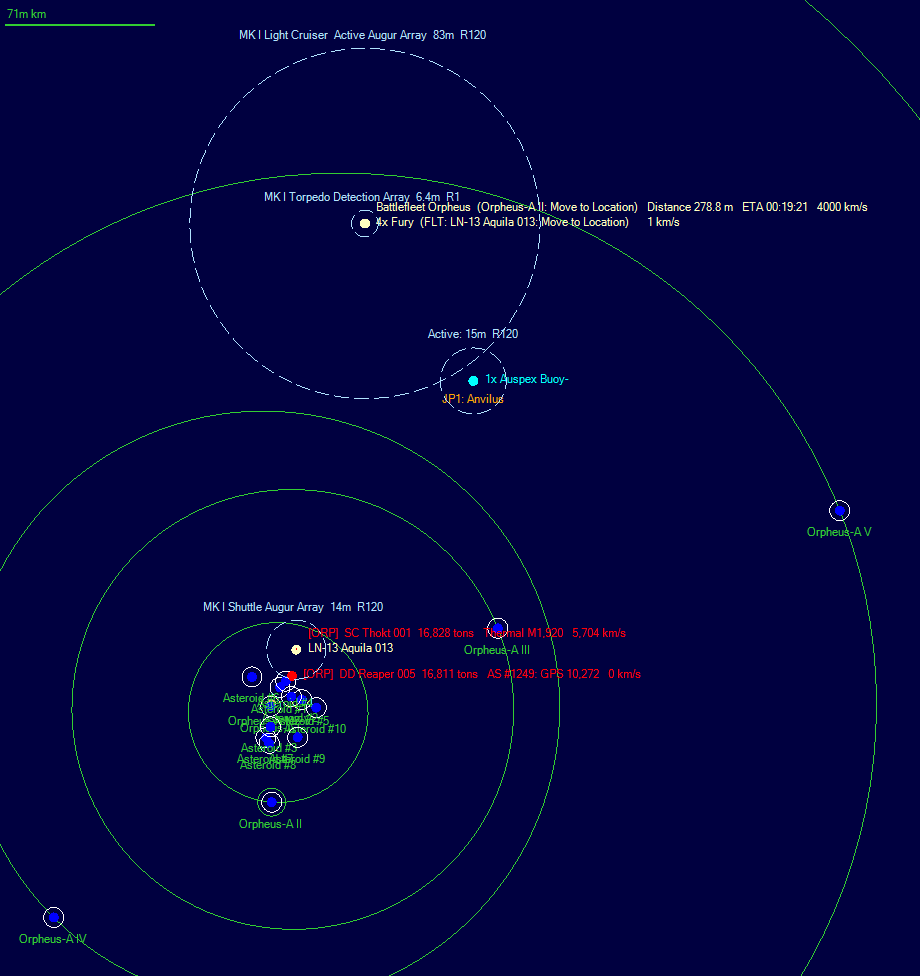
Only minutes later, the Aquila detected sensor emissions from two of the Thanatos ships at twenty-eight million kilometres and was ordered to retreat. The Thokt broke away and disappeared from sensors while the Thanatos began to close the range. As they moved within eighteen million kilometres of the Aquila, without firing any of their long-range torpedoes, Lord-Captain Varvanus decided it was time to proceed on the assumption they had exhausted their magazines. He ordered all Starhawks launched with standard torpedoes. Battlefleet Orpheus was one hundred and seventy million kilometres from the Necrons.
The Necron fleet moved within sensor range of the Aquila, confirming all the known ships were present, apart from the damaged Khopesh and crippled Reaper. By the time they were within eight million kilometres, still without firing, Varvanus was firmly convinced that Battlefleet Orpheus now had an advantage, although the Necrons could still have a supply of their deadly light torpedoes. All the 16,800-ton ships were known to be armed with standard torpedoes, except for the Khopesh which had attacked the surface of Orpheus-A II with turreted bombardment cannon, while the three 50,000-ton Thanatos class had also been detected launching torpedoes, albeit not enough at once to match their size. That left the two 33,000-ton Wraith class as the likely source of the light torpedoes. Lord-Captain Varvanus assigned them the highest priority for the inbound Starhawk strike.
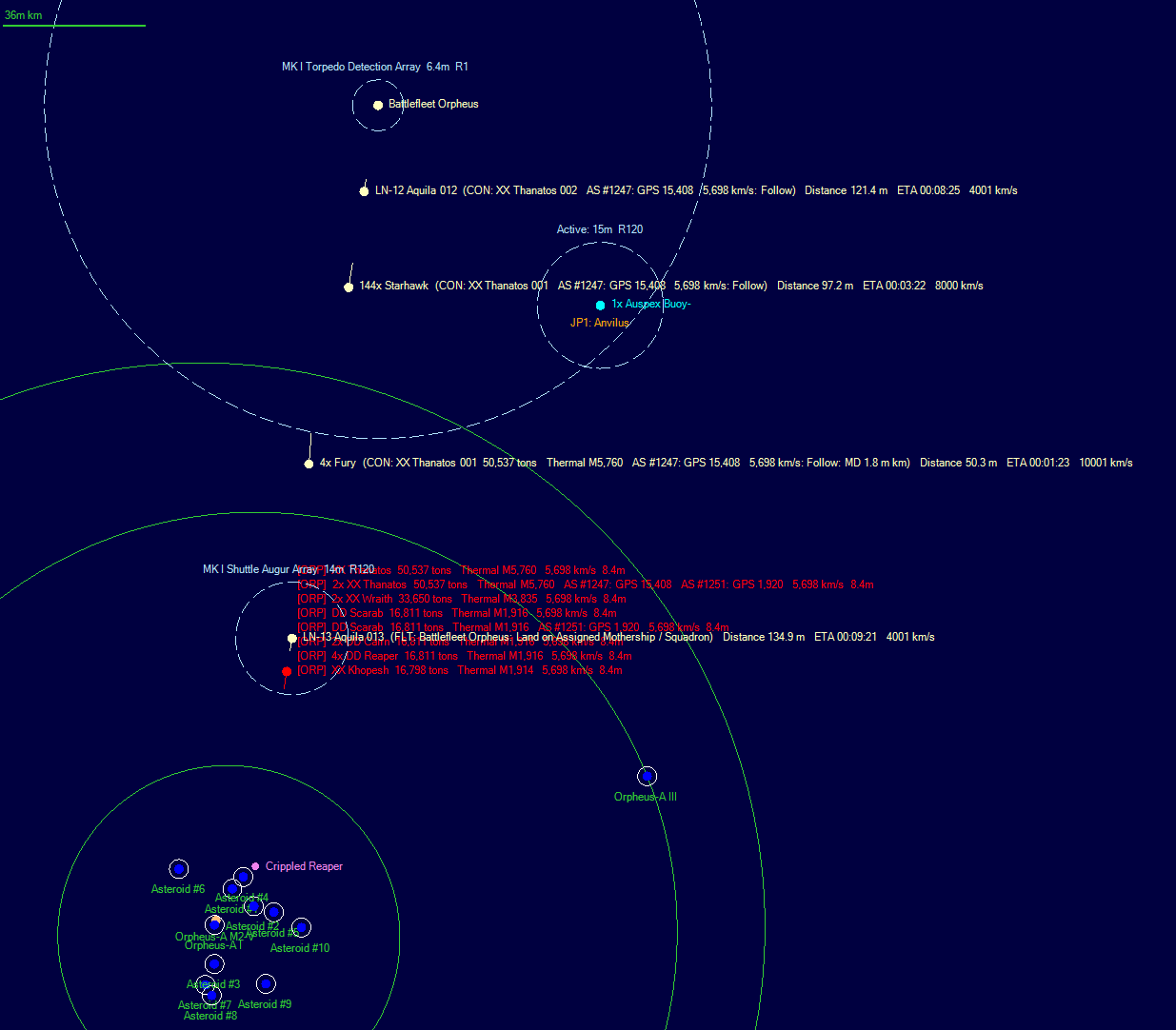
As the Necrons were drawing close to the Aquila and would soon be in light torpedo range, the four interceptors launched earlier to run down the Thokt were redirected to shadow the alien fleet. Even though they only had a sensor range of two million kilometres, the range of the light torpedoes appeared to be less than one point five million. Unfortunately, all those theories were discarded when a salvo of anti-ship torpedoes suddenly took out the Aquila at four million kilometres. The Furies closed in regardless and re-established contact. Battlefleet Orpheus, now at one hundred and twenty-five million kilometres, changed course toward the jump point, just in case this was another Necron ambush.
Twelve minutes after the destruction of the Aquila, the Necrons launched a further eighteen torpedoes at the four Furies shadowing them. The Furies shot down one of the torpedoes, before seven strength-10 detonations obliterated one of their number. The ten torpedoes that missed, reversed course and attacked a different Fury. Apparently, the Necron torpedoes had retargeting capability and onboard sensors. Therefore, when the torpedoes missed and attempted to re-engage, they found their original target was destroyed, at which point the onboard sensors identified a new target and the process repeated. This made the torpedoes particularly effective against small groups of fragile targets, such as fighters.
Another torpedo was taken out by the Furies’ lascannon, then a second Fury was destroyed by six detonations. The third Fury was destroyed by a single torpedo, before the last two torpedoes chased the frantically evading survivor until it too was blown apart. This Necron capability had not become obvious before due to the nature of the targets involved. The lesson for the Imperium was not to send small groups of fighters into Necron torpedo range and certainly not to send groups without any point defence, which described the approaching group of Starhawk bombers. In any event, the loss of the Furies meant the only sensor contact with the Necrons was emissions from two of the Thanatos class ships.
Lord-Captain Varvanus ordered the Starhawks to halt their approach and dispatched the remaining eighty-nine Furies to join them. The Necron fleet continued to advance, moving within a hundred and ten million kilometres of Battlefleet Orpheus before the Furies and Starhawks combined into a single strike force, approximately thirty million kilometres from the Necrons. Several Aquila landers provided sensor coverage.
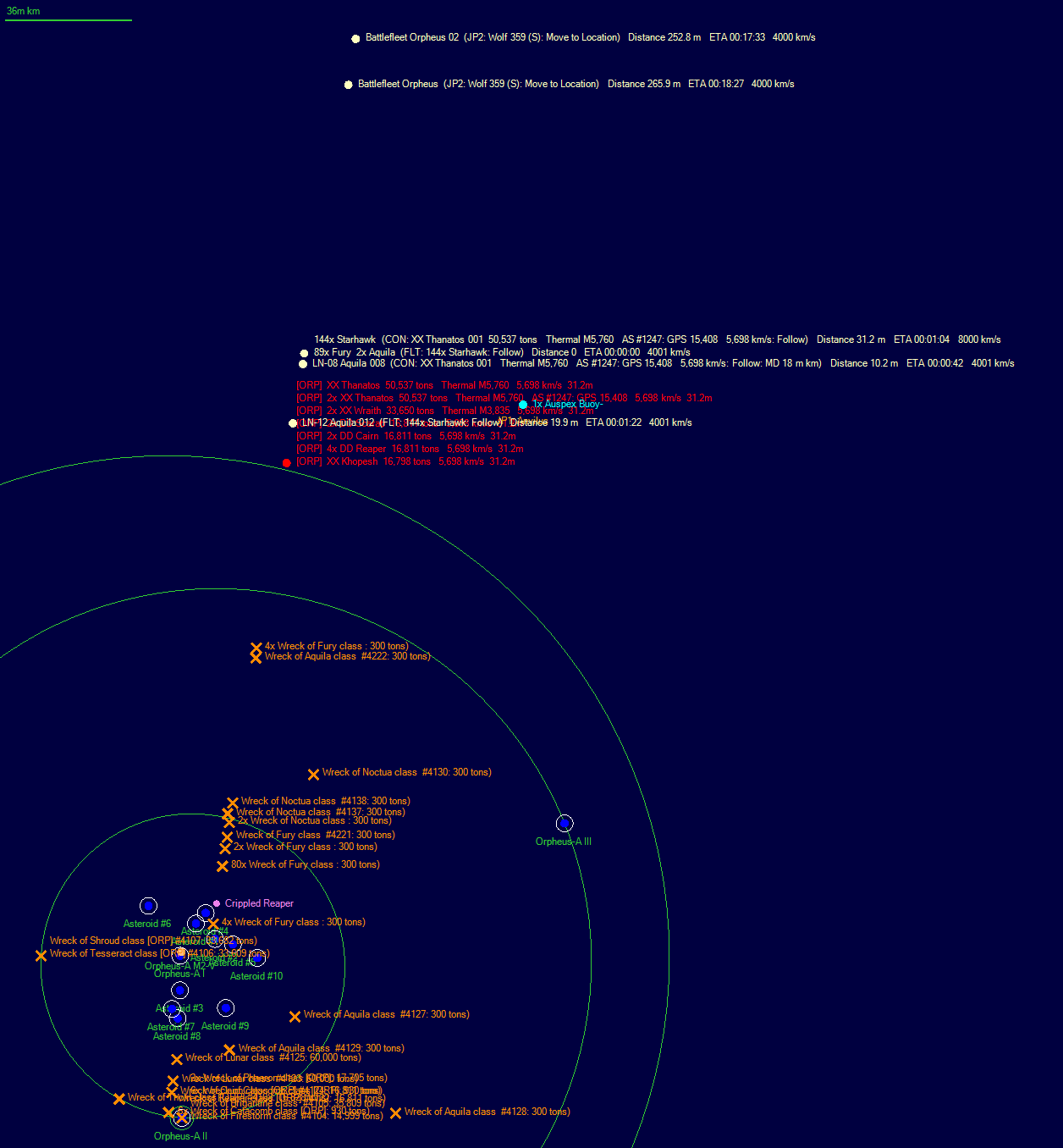
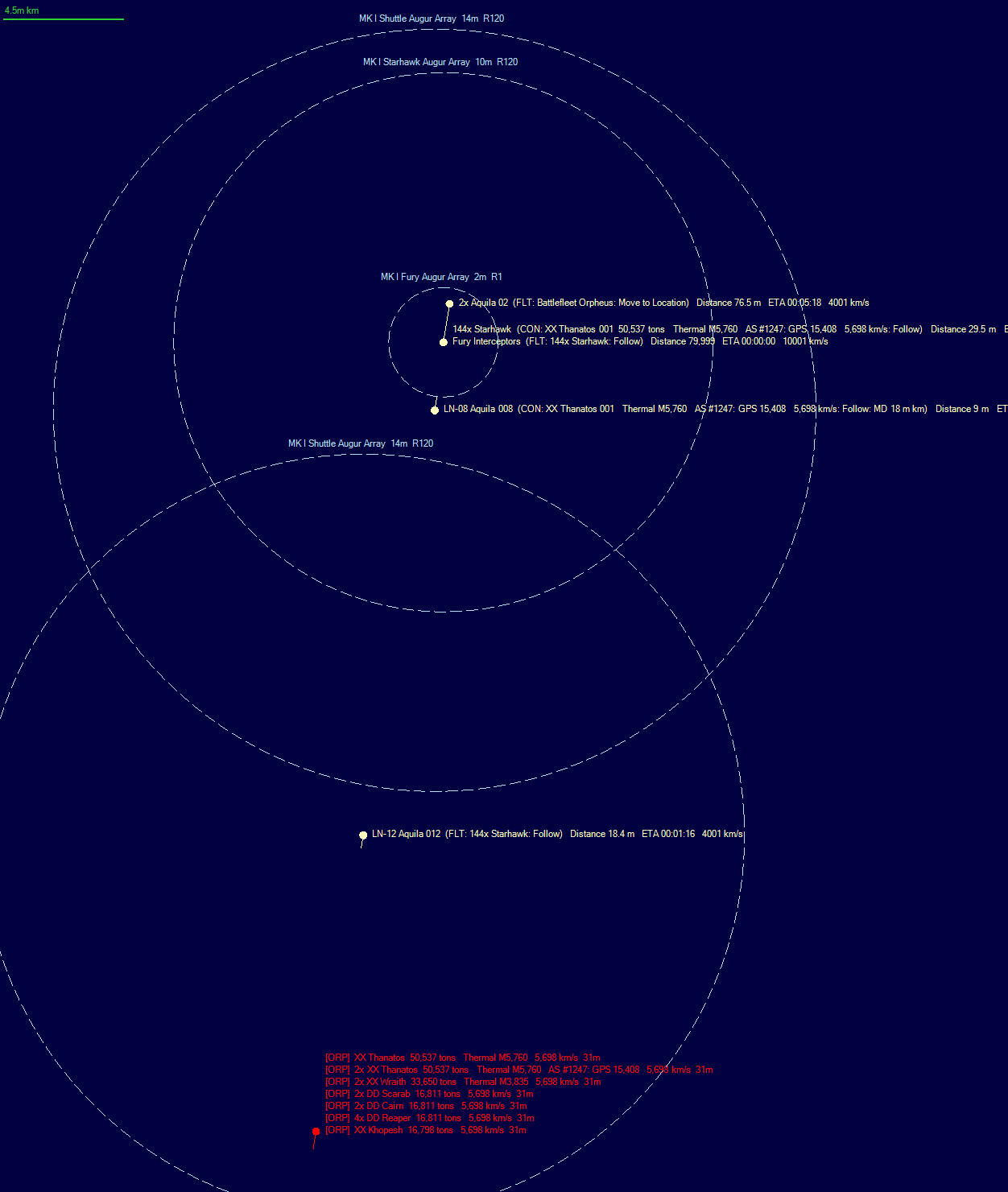
Varvanus ordered the Starhawks to close within the range of their standard torpedoes – approximately eight million kilometres due to the electronic warfare advantages of the Necrons - and focus their main attack on the two Wraith class ships and the remaining Khopesh. There was no hostile torpedo fire as they closed, reinforcing the idea the Necrons were low on ordnance. Forty-two torpedoes were targeted on the Wraith that had been previously attacked, seventy-two on the undamaged Wraith and thirty on the Khopesh. This was a more concentrated attack than the first strike and Lord-Captain Varvanus hoped to eliminate the suspected point defence ships, so the surviving Furies could attack at close range.
Necron light torpedoes began to intercept the inbound strike wave at just over a million kilometres. Almost two hundred strength-1 detonations were recorded, along with fifteen energy-weapon impacts, before the torpedo wave arrived. The previously damaged Wraith was struck thirteen times by strength-25 warheads and exploded, the first Necron warship to be destroyed since Battlefield Orpheus returned to the system. The undamaged Wraith received thirteen hits, four of which resulted in armour penetrations that slowed the ship to one quarter speed. Decoys launched by the Wraith attracted twenty of the inbound torpedoes, which almost certainly saved the ship from destruction. The Khopesh escaped relatively lightly with only five hits, one of which penetrated, and no reduction in speed.
Lord-Captain Varvanus ordered the Furies to protect the Starhawks as they returned to the carriers, while he waited to see what the Necron fleet would do. The damaged Wraith dropped out of formation, reversed course and headed back toward Orpheus-A II at 1426 km/s. All the remaining Necron ships continued on course toward Battlefleet Orpheus, which was retreating toward the jump point to reduce the rate at which the range between the two fleets was decreasing.
Twenty-three minutes after the attack, an Aquila struggling to escape due to its maximum speed of 4000 km/s, had fallen to within three million kilometres of the Necrons. It detected a single inbound torpedo. Either the Necrons were almost out of torpedoes, or they had changed tactics to conserve whatever ordnance remained. The Aquila tried to intercept with its heavy bolter, but to no avail. It was destroyed by a single strength-1 detonation. Three other Aquila were in the vicinity, so they moved onto diverging courses in an attempt to avoid the advancing Necron fleet.
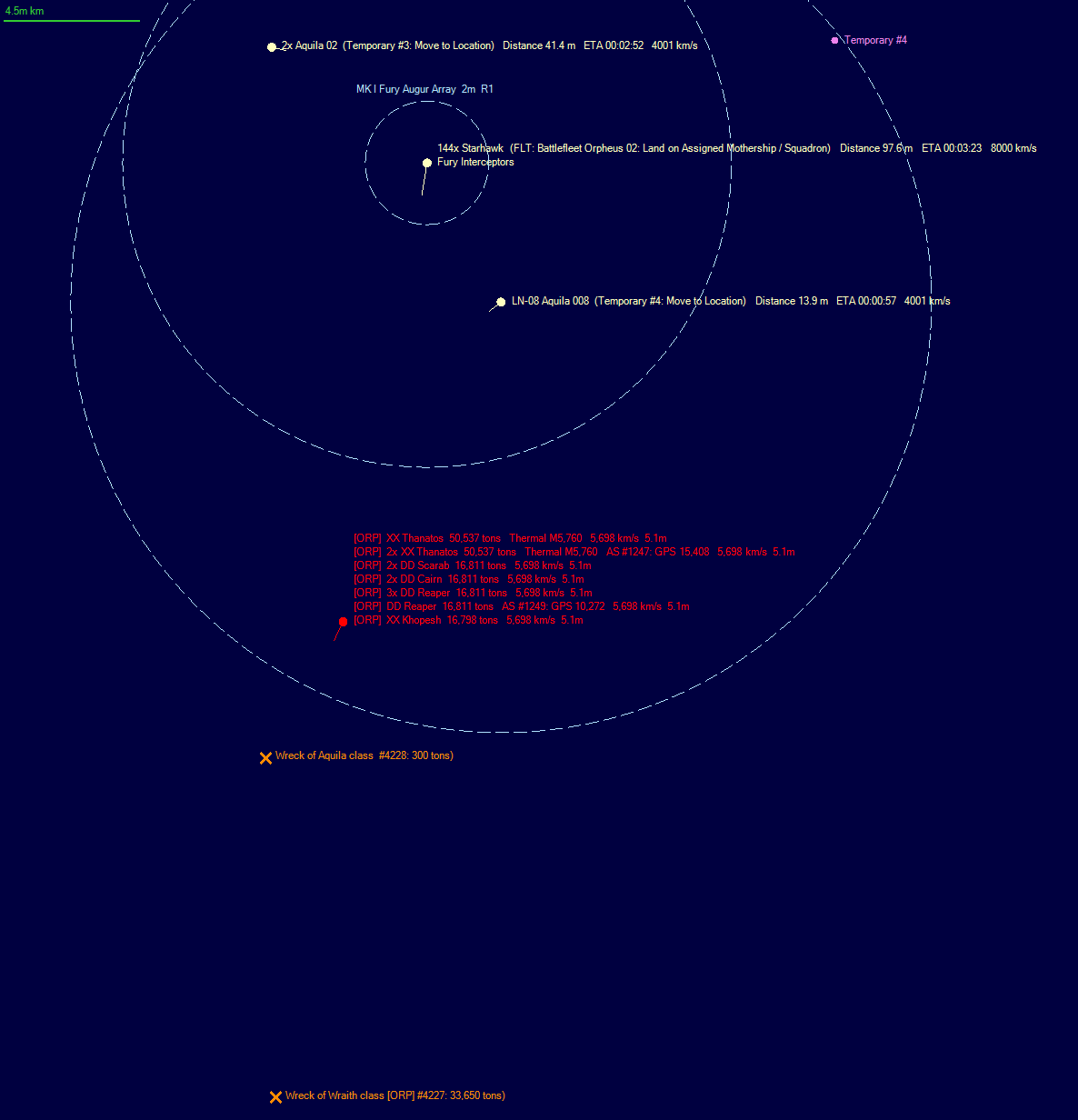
Once the Starhawks were over twenty million kilometres from the Necron fleet and relatively safe from attack, Lord-Captain Varvanus ordered the remaining Furies to abandon their escort mission and attack the Necrons. The retreating Wraith was well out of range, so it was time to discover exactly what defensive capabilities remained within the alien fleet. If they made it to point-blank range, their first target would be the damaged Khopesh, which was armed with turret-mounted bombardment cannon. At one point eight million kilometres from the enemy fleet, they were confronted by another new tactic. Eighteen torpedoes approached in two waves of four and one of ten, separated by a few seconds. This was possibly an attempt by a Necron ship to use a single fire control to engage multiple targets. Twelve torpedoes were shot down and three Furies destroyed.
The Furies moved well within light torpedo range, with no sign of hostile fire, reinforcing the idea that the two Wraith class cruisers were responsible for the ambush of the earlier Fury attack. At two hundred thousand kilometres, the Necrons reversed course and headed directly away from the approaching interceptors. At seventy thousand kilometres, three Furies were destroyed and a fourth disabled by bombardment cannon fire from the Khopesh, classified as a frigate.
Five seconds later, a further four Furies were destroyed, although they were able to return fire from 37,500 km and inflict over fifty strength-1 hits on the Khopesh, including fourteen that penetrated its armour. The third volley from the Khopesh killed four more Furies, before it was buried under an avalanche of lascannon fire, suffering forty-five internal hits. The Necron fleet chose that moment, with the fighters at point-blank range, to launch sixty-one anti-ship torpedoes.
Ten Furies exploded within seconds, but thirty-seven torpedoes remained, having missed their targets and turned to attack again. The Necron fleet launched a further sixty-four torpedoes, possibly using the same fire controls to launch multiple smaller salvos. The sixty-five surviving Furies were suddenly in significant trouble. Lord-Captain Varvanus briefly considered ordering them to run, on the basis the Necron torpedo fire controls might have very limited range against such small targets, but even if that were true they would still have to re-enter that range to attack again, so he ordered them to press their attack while they still could.
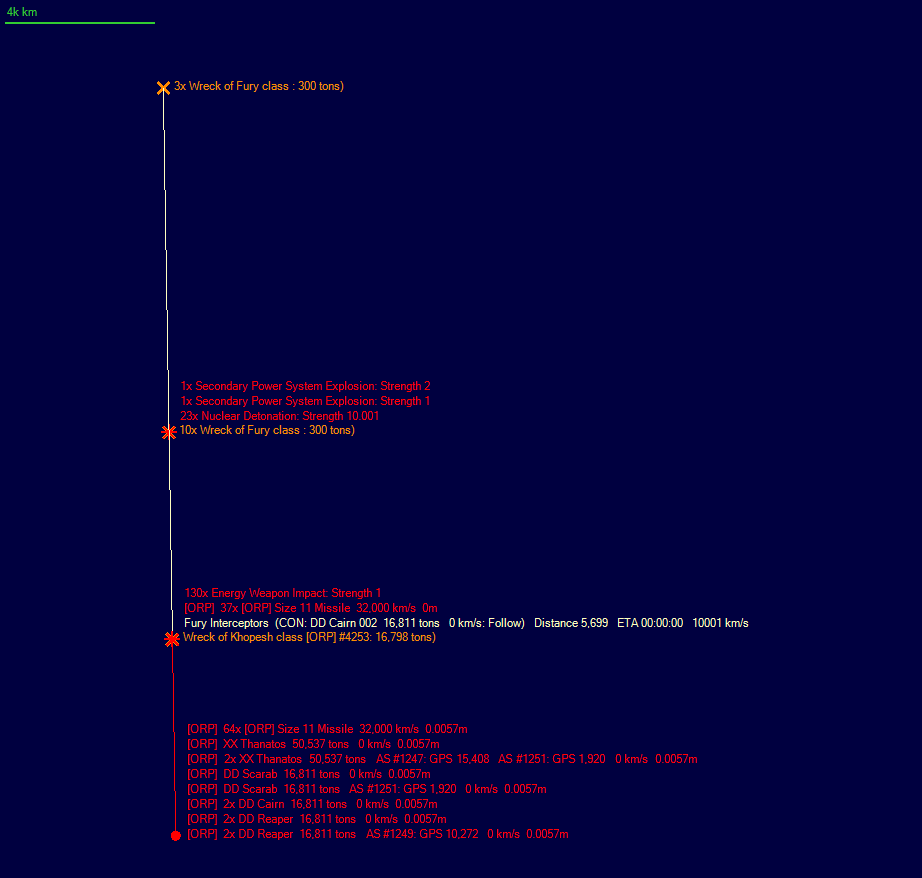
Sixteen Furies exploded within the next few seconds amid forty-nine strength-10 detonations. Fifty-two torpedoes were still hunting targets and the Necron ships launched a further forty. Thirteen more interceptors were lost before the Necrons launched yet another wave. Thirty-six Furies faced eighty-eight torpedoes. All the analysis suggesting the Necrons were out of torpedoes was plainly incorrect. Once again, they had drawn the Imperial Navy into a devastating ambush.
The rate at which new torpedoes were appearing finally slowed. Thirty, then two salvos of only a dozen, then a few singles, until finally the Necrons ships stopped launching. The existing torpedoes continued to hunt down the Furies, destroying several in each pass as their numbers reduced. The interceptors were firing on the Necrons, even as they were being wiped out, and managed to overwhelm a Cairn class destroyer. Finally, ninety seconds after the first torpedoes were launched, the last one was shot down by a Fury. Only eleven Fury Interceptors remained from the original one hundred and eighty that were embarked on the carriers.
Those eleven interceptors had several minutes to inflict as much damage as possible before the Necron launchers recycled, so firstly they targeted those ships damaged by earlier torpedo strikes and opened fire, destroying a Scarab class destroyer and then a Reaper. Five minutes had passed since the first launch, so Lord-Captain Varvanus ordered them to attack a Thanatos class cruiser. The 50,000-ton warship withstood their attack for almost four minutes, until it was blown to pieces by a pair of large secondary explosions. Concerned about their remaining time and rapidly depleting maintenance supplies, they changed targets to a Reaper class destroyer.
The Reaper slowed as it suffered multiple internal hits, at which point it suddenly broke away on a course to the outer system, while the rest of the Necron fleet, now comprising two Thanatos class cruisers and four 16,800-ton destroyers, set a directly-opposing course, back toward the inner system. By the time the Reaper was eliminated, the other Necron ships were 200,000 km away. Almost ten minutes had passed since the last torpedo launch. Varvanus ordered the Furies to pursue. Maybe this time, the Necrons really were out of ordnance.
Just as they drew close, the Necrons launched a pair of torpedoes, which were shot down, followed by another pair five seconds later, which destroyed a Fury. Varvanus ordered the interceptors to maintain their attack on a Cairn class destroyer. The Necrons continued to launch pairs of torpedoes and the Furies began to die. With only two interceptors remaining, the Cairn exploded, so Varvanus gave them permission to escape if possible. They didn’t make it. The last torpedo attacked the last Fury several times, using decoys to avoid point defence, until it finally impacted.
Eighty-five Fury class interceptors had mounted the latest attack. Despite the total loss of every engaged Fury, they had eliminated a Khopesh class frigate, five destroyers and a 50,000-ton cruiser. The Necron fleet now comprised a pair of Thanatos class cruisers, a Scarab class destroyer and two Reaper class destroyers. Several damaged Necron ships were last seen heading towards the inner system, including a Wraith class light cruiser, a Reaper class destroyer, a Khopesh class frigate and a Thokt class scout. The five intact Necron warships changed course to intercept one of the Aquila class landers that was maintaining sensor contact. At three million kilometres they launched a single torpedo that obliterated the 300-ton Aquila, then vanished from Imperial sensors.
Battlefleet Orpheus, a hundred million kilometres from the recent battle, continued on course toward the Wolf 359 jump point while Lord-Captain Varvanus waited for the Starhawks to land and re-arm. There were enough Standard torpedoes on the six carriers for one more strike. An Aquila was also heading home, while a second set course for the inner system to monitor Orpheus-A II. Varvanus planned to find the Necrons again when he was ready to finish the battle.
Three hours later, emissions from the two Thanatos class cruisers were detected ninety million kilometres from Battlefleet Orpheus. The Necrons were plainly in pursuit, so perhaps their ordnance was still not exhausted. They were within theoretical active sensor range of the Lunar class cruisers, so Holy Flame engaged her active augur array. The Necrons were not detected, so it was likely they had advanced sensor jamming technology. Activating the sensor did have a different effect – the Necrons suddenly reversed course.
Until this point, only Bloodhawk, a Dauntless class light cruiser, had her sensors active, so it was possible the Necrons had underestimated the size of the Imperial Navy task group. Lord-Captain Varvanus ordered his fleet to reverse course and give chase. The Starhawks landed thirty minutes later and began to load torpedoes. Eight hours later, the Necron fleet reappeared at the edge of sensor range, close to the Anvilus jump point.
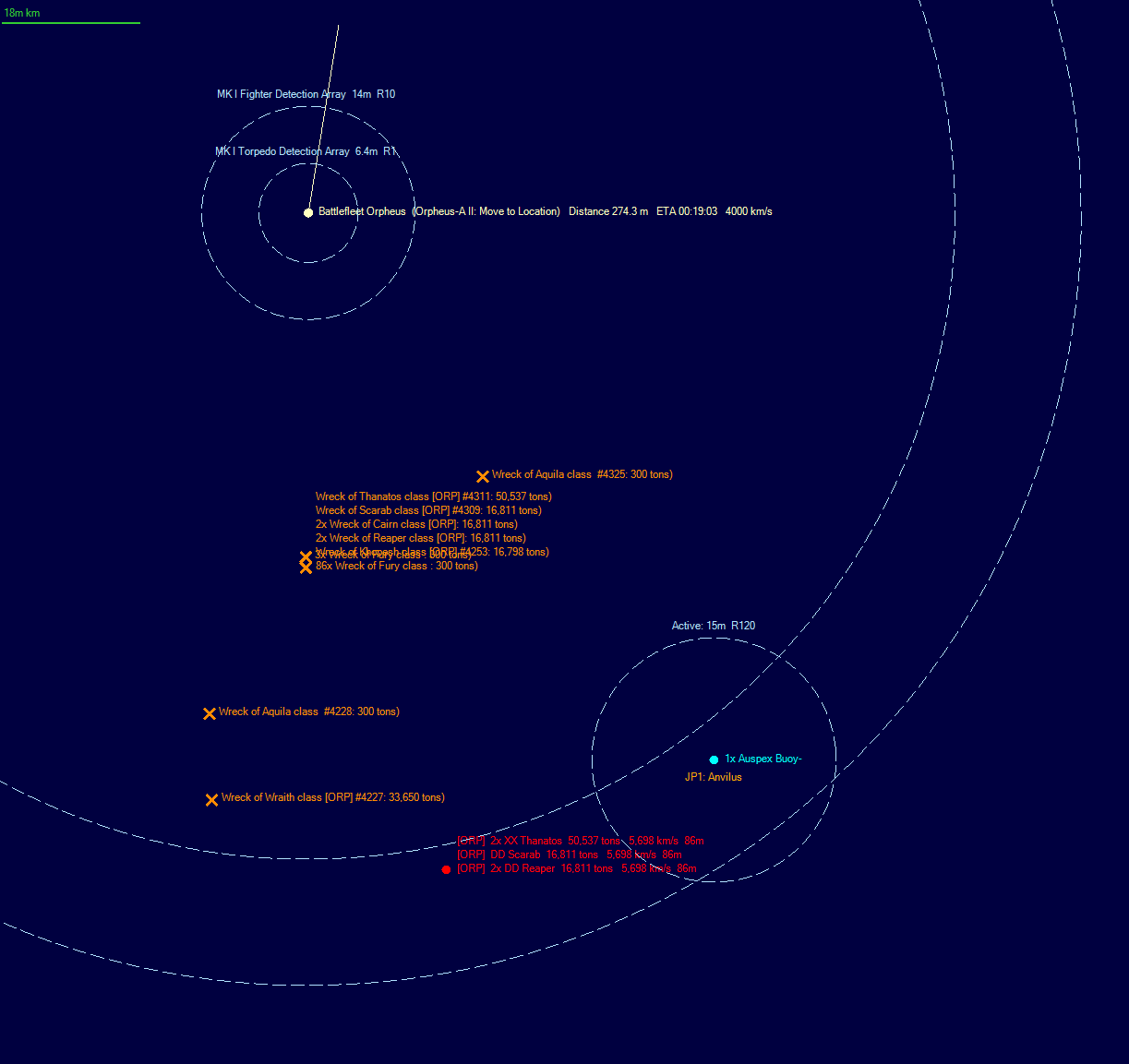
Lord-Captain Varvanus ordered all one hundred and forty-four Starhawks to launch and head for the alien ships. The Necrons reversed course again and soon moved out of sensor range. The Starhawks continued outward, adjusting their course when emissions were detected from the Thanatos class cruisers, while Battlefleet Orpheus headed for the inner system. Seven hours after the initial contact, the damaged Wraith class cruiser was detected by active sensors in the direction of Orpheus-A II. The Necron fleet was continuing to move away, with emissions detected near Orpheus-A III, rather than the second planet, which was being monitored by an Aquila. The crippled Reaper, still dead in space, was also detected via its sensor emissions.
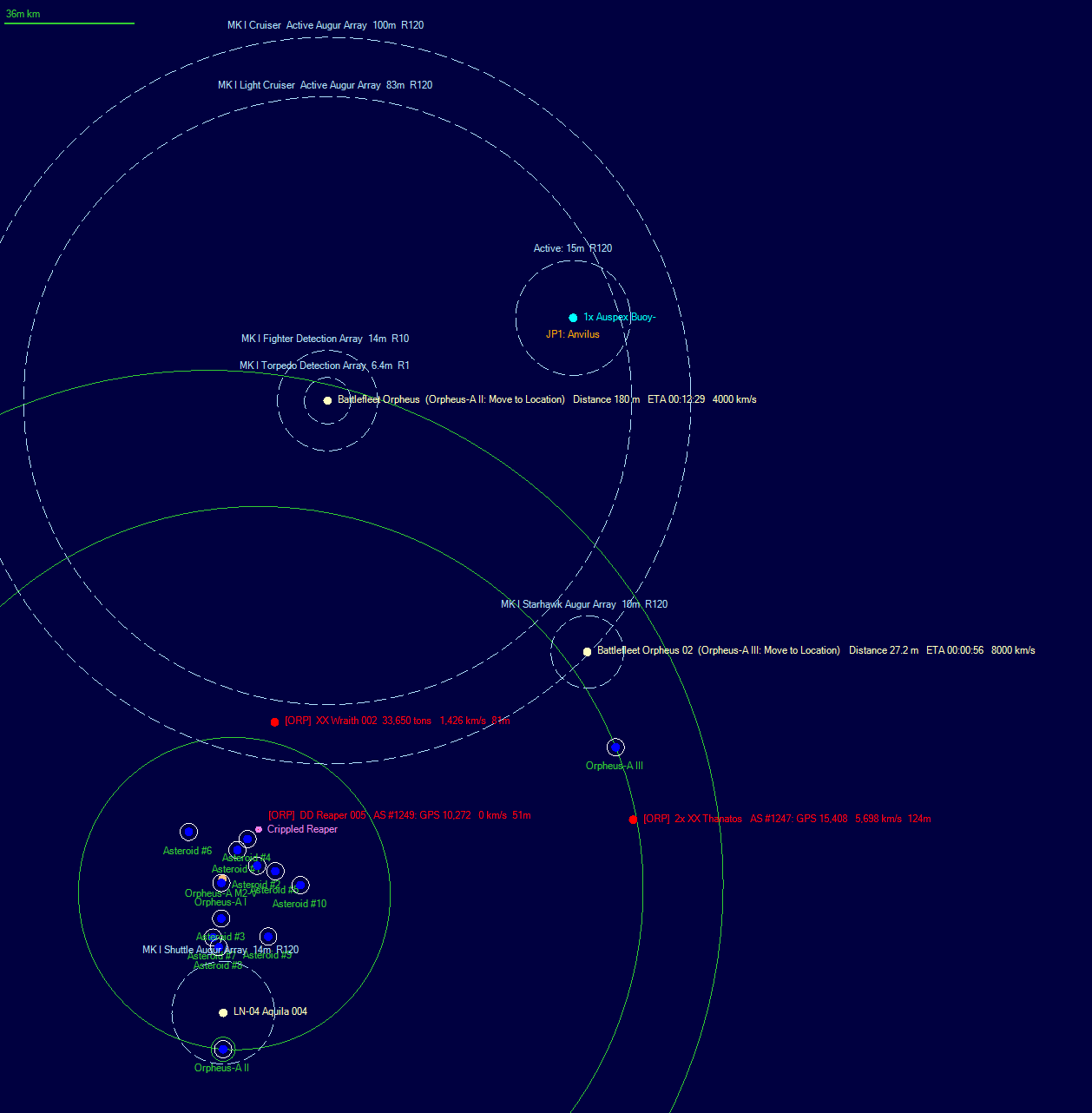
At 7.30am, on September 20th 4004, the Starhawks moved within active sensor range of the Necron fleet. They launched one hundred and forty-four Standard Torpedoes, targeted on the two Thanatos class cruisers. This time, there was no Wraith with light torpedoes, or a Khopesh with point defence. Over half of the torpedoes missed, due to the speed of the Necron ships and their superior electronic warfare capability and half of the rest were distracted by decoys. The first Thanatos was hit by seventeen strength-25 warheads, with four detonations penetrating its armour. The second suffered only twelve hits, half of which penetrated due to multiple hits in the same location, then suddenly vanished amid a catastrophic strength-143 secondary explosion. The Necron fleet now comprised one damaged cruiser and three intact destroyers.
The Starhawks, which had moved within four million kilometres of the Necrons during the attack, set a course for their carriers. As they moved away one was struck by two torpedoes and destroyed. The bombers did not have torpedo detection sensors so they could not determine if more were inbound. The victorious return home suddenly become a terrifying death ride, as one Starhawk after another vanished in strength-10 detonations. Without point defence, every inbound torpedo continued to attack until it hit. A dozen Starhawks were lost before the attacks finally ceased.
As Battlefleet Orpheus was closing in on the damaged Wraith and crippled Reaper, it detected a salvo of seventeen inbound torpedoes. Given the direction, they were almost certainly from the Reaper, which had lost its engines but apparently only one of its torpedo launchers. Unfortunately, the fleet was running with shields down to avoid giving the Necrons any information about its strength. Those shields begin gaining strength as the fleet reversed course, but would only be at forty percent strength when the torpedoes arrived. The four cruisers, two light cruisers and two strike cruisers activated their point defence tracking and engaged the inbounds
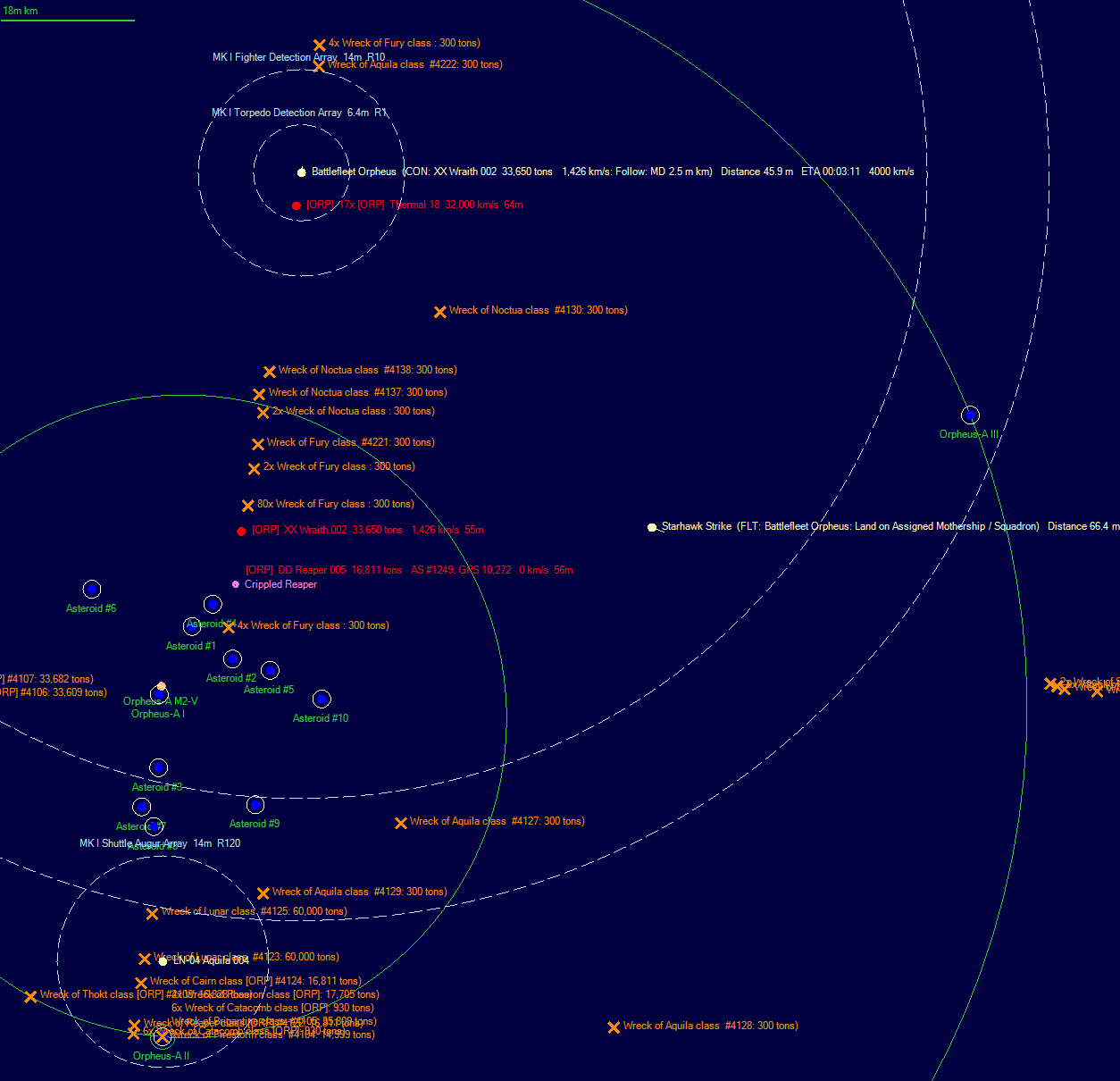
Sixteen torpedoes were hit by point defence, leaving one to impact on the shields of the carrier, Archon Kort. There were no subsequent attacks, so it was likely the destroyer lost its magazine and only had the torpedoes already in their launchers. Two hours later, the Starhawks landed on the carriers. Lord-Captain Varvanus considered detaching the carriers, as they had no interceptors remaining and their magazines were empty. However, given the recent attack and the lack of information regarding the current location of the four ships remaining in the Necron fleet, he decided it would be safer for them to remain with the other warships.
Once Battlefleet Orpheus was within fifty thousand kilometres of the crippled Reaper, Varvanus ordered the strike cruiser Eternal Defiance to conduct a boarding operation with its two space marine companies. They landed on the hull, entered through the damaged armour and wiped out the remaining ‘crew’, which was entirely robotic, within sixty seconds. The Reaper had magneto-plasma engines, two generations ahead of the Imperial Navy’s gas-core technology, which explained its superior speed and the effectiveness of its torpedoes.
Reaper class Missile Destroyer 16,812 tons 308 Crew 2,619.6 BP TCS 336 TH 1,920 EM 0
5710 km/s Armour 5-58 Shields 0-0 HTK 75 Sensors 8/0/0/0 DCR 3-1 PPV 59.4
Maint Life 0.13 Years MSP 292 AFR 754% IFR 10.5% 1YR 2,167 5YR 32,508 Max Repair 480 MSP
Magazine 1,461 / 44
Captain Control Rating 2 BRG AUX
Intended Deployment Time: 12 months Morale Check Required
Magneto-plasma Drive EP960 (2) Power 1920 Fuel Use 20.41% Signature 960 Explosion 10%
Fuel Capacity 600,000 Litres Range 31.5 billion km (63 days at full power)
Size 22 Decoy Launcher (2) Decoy Size: 22 Hangar Reload 234 minutes MF Reload 39 hours
Size 11 Missile Launcher (30.0% Reduction) (18) Missile Size: 11 Rate of Fire 800
Missile Fire Control FC85-R107 (2) Range 85.7m km Resolution 107 ECCM-2
Active Search Sensor AS74-R107 (1) GPS 10272 Range 74.2m km Resolution 107
Thermal Sensor TH1-8 (1) Sensitivity 8 Detect Sig Strength 1000: 22.4m km
Electronic Warfare Jammers: Sensor 2 Fire Control 2 Missile 2
Eternal Defiance remained behind to recover her marines, while the rest of Battlefleet Orpheus headed for the damaged Wraith, retreating at 1,426 km/s. Once within two million kilometres, the carriers were detached while the other seven Imperial Navy ships closed in. Lord-Captain Varvanus was intent on capturing this ship too, unless it still had a significant light torpedo capability. As soon as Battlefleet Orpheus closed within a million kilometres, the Wraith launched sixty-eight light torpedoes. Varvanus ordered a retreat and instructed his four cruisers to launch torpedoes, ultimately with the aim of destroying the Wraith, but also to attract any further light torpedo salvos.
Thirty-nine light torpedoes were killed by point defence. The rest impacted on the shields of the light cruiser Bloodhawk. All four cruisers launched within ten seconds of the order, so the thirty-two standard torpedoes became the focus of the Wraith’s light torpedoes, allowing Battlefleet Orpheus to retreat out of range. The Wraith was unable to defeat the attack and was destroyed by multiple strength-25 detonations. The once mighty Necron fleet had been crushed, but the campaign was not yet over. The damaged Thanatos class cruiser was still at large, along with three escorting destroyers. There was also a damaged Khopesh class frigate and a Thokt class scout somewhere in the system.
Lord Captain Varvanus left the cruisers Justicar and Holy Flame, plus the strike cruiser Eternal Defiance, in the inner system to guard the captured Reaper until a tug could arrive from Terra and watch for any activity. The rest of Battlefleet Orpheus headed for the Wolf 359 jump point. Varvanus planned to send the carriers home, then use his ships to guard three salvage ships that were waiting in Wolf 359 while they recovered the Necron wreckage. Eighteen hours later, Holy Flame briefly detected the Necron fleet as it moved within sensor range and then pulled back. The pattern continued for several days, with the alien ships moving in and out of sensor range in the area between Orpheus-A III and the Anvilus jump point.
Meanwhile, the carriers transited into Wolf 359 and headed home, escorted by the light cruiser Dauntless. The remaining four ships in the main body of Battlefleet Orpheus – the cruisers Agrippa and Righteous Fury, the light cruiser Bloodhawk and the strike cruiser Holy Execution, moved to the first group of wrecks and watched over the salvage operations carried out by Phoenix, Gryphon and Wyvern, with their six accompanying freighters. Two weeks after the battle, with the Necrons remaining at a distance, the tug Atlas began towing the captured destroyer back to Terra, so Justicar, Holy Flame and Eternal Defiance moved into orbit of Orpheus-A II, to the great relief of the Imperial Guard troops on the surface.
On October 28th, a Universe class mass conveyor delivered two tracking stations to Orpheus-A II, allowing much better sensor coverage. Emissions from the Thanatos were detected, but there was no sign of the missing Khopesh or Thokt class ships. A week later, a fleet of four mass conveyors delivered ten maintenance facilities and a refuelling station. While there were no immediate plans for new colonists, the planet would soon function as a military base once again.
Salvage operations in Orpheus were complete by the end of December 4004. To the disappointment of Imperium scientists, no engine technology was recovered from any of the wrecks. With no need to protect the salvage ships, the Imperial Navy presence in Orpheus could be reduced temporarily. The cruisers Justicar and Holy Flame, plus the strike cruiser Eternal Defiance, were ordered home for overhaul. The cruisers Agrippa and Righteous Fury, the strike cruiser Holy Execution and the recently arrived frigate Vortex moved into orbit of Orpheus-A II, so the Ordo Machinum formation on the surface could carry out recovery operations. The light cruiser Bloodhawk and another frigate, Final Silence, picked the Anvilus jump point, to extend sensor coverage and allow an easy escape if they came under torpedo attack.
There had been no sign of the remaining Necron warships for several weeks, although the Thokt class scout had reappeared and was moving in and out of sensor range. Lord-Captain Lucifer Varvanus had returned to Terra to organise the re-arming and overhaul of the carriers, which would soon be returning to Orpheus, so Lord-Captain Darius Invictus of the Agrippa was in command of Imperial Navy forces in the system. He ordered the ships at Orpheus-A II to deactivate both shields and augur arrays, relying only on the planetary sensors, in order to lure the remaining Necron ships closer to the planet. The tactic worked better than expected, as the Thokt moved within several million kilometres and was taken out by a salvo of torpedoes.
A few days after the destruction of the Thokt, six previously unknown Necron ships, designated as Novokh class, were detected via their engine emissions on a slow approach to the inner system, moving at only 276 km/s. They moved into orbit of Orpheus-A IV, a gas giant, then disappeared from sensors as their engines shut down. The gas giant had a quarter of a million tons of accessibility 1.0 Sorium, so it was possible they were fuel harvesters. Lord-Captain Darius Invictus left Vortex in orbit of Orpheus-A II and took his other three ships toward the last known position of the Necrons.
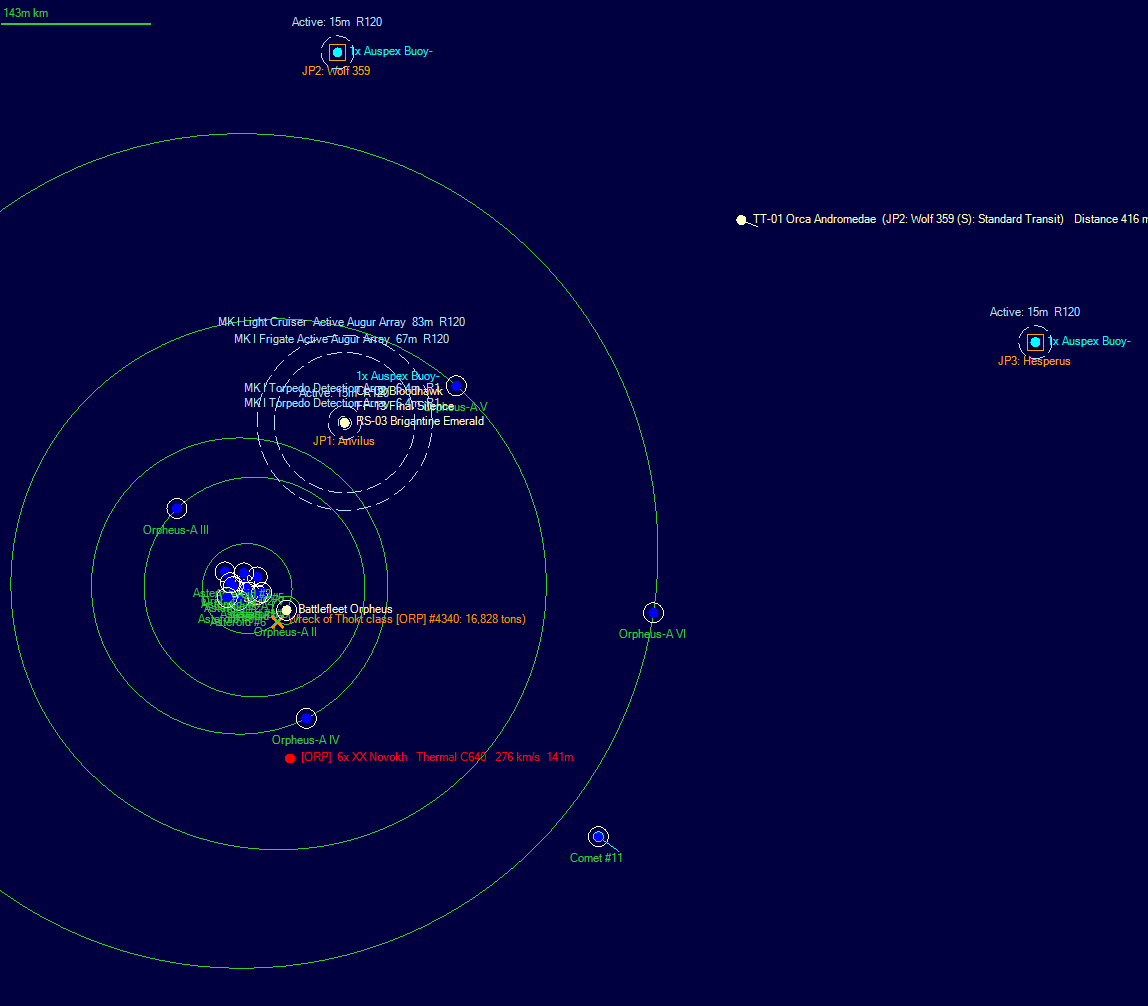
At forty million kilometres, the cruisers engaged their active augur arrays and detected the six Novokh class ships, which were 115,000 tons, plus a pair of 33,000 ton Wraith class light cruisers, armed with light torpedoes and presumably acting as escorts. Invictus ordered his ships closer, with the intention of using Agrippa and Righteous Fury to engage with torpedoes, in an attempt to wear down the Wraiths. They could not easily escape while tied to the slow-moving Novokhs.
The Wraith engaged the first wave of sixteen torpedoes with their light torpedoes, destroying ten of them. Each torpedo had eleven decoys, which made them difficult targets. Two more missed and a third was distracted by a decoy, but three detonated their strength-25 warheads close to one of the Wraiths, inflicting armour damage. Only a single torpedo from the second wave, launched thirty minutes later, found its target, with two more hitting decoys. The third wave was far more effective, with seven torpedoes striking the Wraith and three penetrating its armour. The Necron warship broke away from the other ships at 4279 km/s, indicating it had engine damage, and ran directly away from Battlefleet Orpheus.
Lord-Captain Darius Invictus ordered his ships to manoeuvre around the slow-moving Novokhs and the intact Wraith, in order to get a clear shot at the retreating ship. The fourth wave faced only minimal defensive fire. Eleven strength-25 detonations blew the Wraith to pieces. The two cruisers only had enough torpedoes left for two more salvos, which they directed at the remaining, undamaged Wraith. They achieved eight hits, none of which penetrated the armour. Invictus considered ordering his ships to close to energy range, but the Wraith had approximately seventy light missile launchers and his ships did not have the point defence capability to degrade the attacks enough to survive. He decided to hold his distance and await the arrival of Lord-Captain Varvanus and the carriers.
Five days later, six Dictator class carriers and two light cruisers joined Battlefleet Orpheus. Command passed back to Lord-Captain Lucifer Varvanus. His first act was to dispatch thirty-two Starhawks to engage the damaged Wraith class light cruiser. While the Imperium’s standard torpedoes were proving effective, they were also expensive and time-consuming to produce. All the Starhawks were loaded with a torpedo, but the carriers only had enough for a single reload. Combat against the Necrons had quickly burned through the Imperium stockpile and it would take some time to rebuild it. On that basis, he decided a smaller strike would preserve his available ordnance. The Wraith shot down several torpedoes, but was overwhelmed and destroyed by thirteen strength-25 hits.
That left the six suspected fuel harvesters. Both Thunderhawks from Eternal Defiance launched a boarding attack, capturing one of the ships in four minutes of intense combat, that cost the lives of five space marines. The Novokh was indeed a fuel harvester, but also had a pair of magneto-plasma engines. Scrapping the ship to gain access to the engine technology would likely be more valuable to the Imperium than using it as a fuel harvester, especially as large quantities of fuel were being retrieved from the xenoarchaeological sites. Over the next thirty hours, the space marines boarded and captured the other five Novokhs.
Novokh class Fuel Harvester 115,848 tons 516 Crew 1,977.9 BP TCS 2,317 TH 640 EM 0
276 km/s Armour 1-211 Shields 0-0 HTK 256 Sensors 0/0/0/0 DCR 1-0 PPV 0
MSP 10 Max Repair 80 MSP
Commander Control Rating 1 BRG
Intended Deployment Time: 3 months
Fuel Harvester: 43 modules producing 1,720,000 litres per annum
Commercial Magneto-plasma Drive EP320.0 (2) Power 640 Fuel Use 4.42% Signature 320 Explosion 5%
Fuel Capacity 1,200,000 Litres Range 42.2 billion km (1767 days at full power)
Refuelling Capability: 60,000 litres per hour Complete Refuel 20 hours
CIWS-200 (2x4) Range 1000 km TS: 20,000 km/s ROF 5
In February 4005, the salvage ship Phoenix was back in Orpheus. She had already salvaged the wreck of the Thokt and was working on the first of the two Wraith wrecks. The cruisers Agrippa and Righteous Fury, the strike cruiser Holy Execution and the frigate Vortex were providing cover, while the six carriers and the light cruisers Dauntless and Cerberus were in orbit of Orpheus-A II, approximately a hundred and seventy-five million kilometres away. All the ships had their shields deactivated and the only ship with active sensors was the frigate, trying to portray an inviting target for the Thanatos cruiser and three destroyers that lurked somewhere in the outer system. The ploy worked. Tracking stations on the planet detected the thermal output from the engines of the cruiser as it moved toward the frigate. Lord-Captain Varvanus ordered the bombers to launch immediately and attack before the Necron cruiser could get within torpedo range.
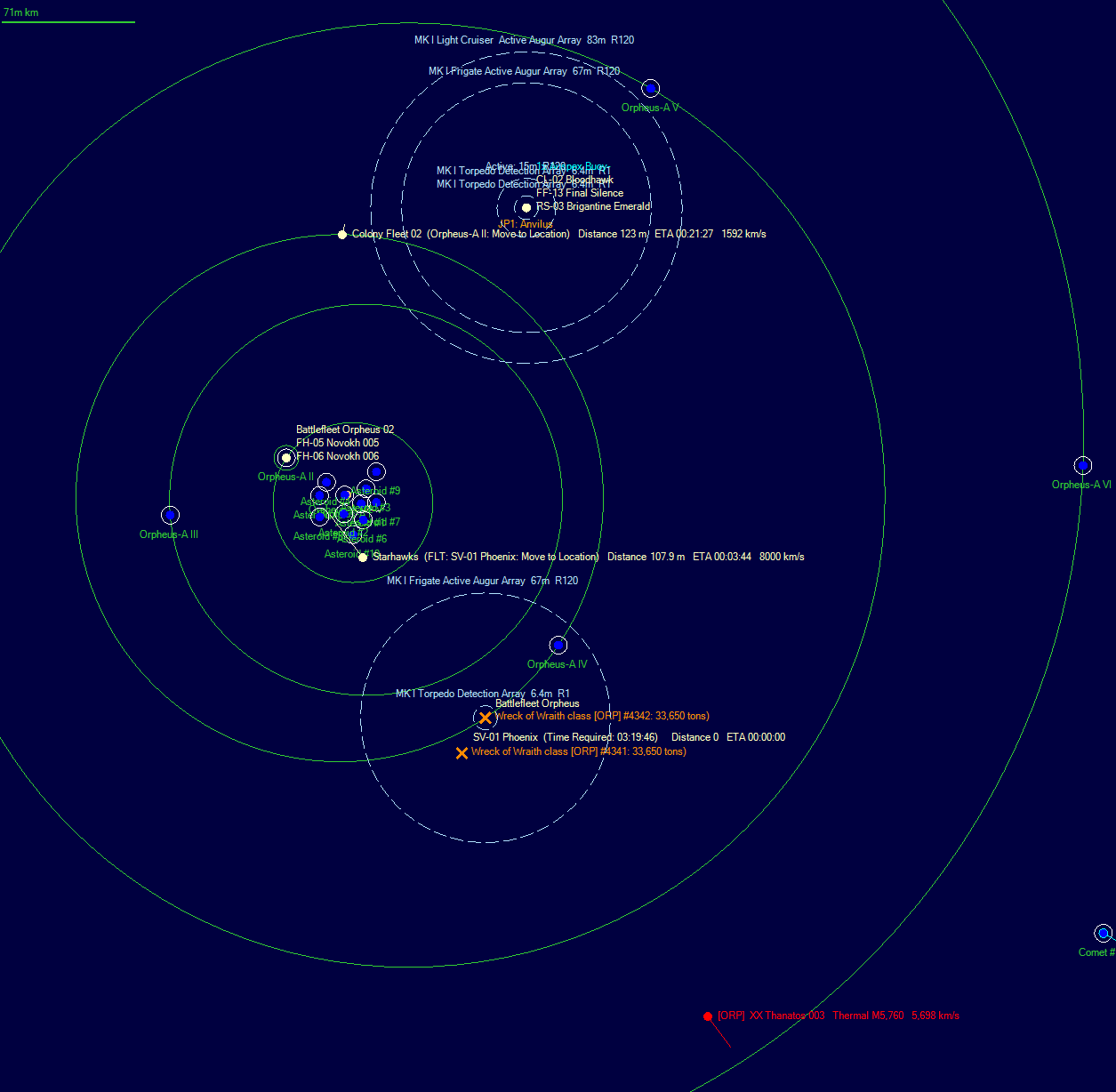
Once the Starhawks passed the salvage ship, with the Thanatos now deep within the range at which it could be tracked by its engines, Lord-Captain Lucifer Varvanus, ordered the other ships with the frigate to engage shields and active sensors. He was more concerned now about allowing an attack, than luring the Thanatos closer. The latter objective had already been achieved. The Thanatos and its three accompanying destroyers were undeterred and continued closing.
The Necron ships were seventy-four million kilometres from the salvage ship and its protective screen when the one hundred and thirty-two Starhawks entered weapon range. The Thanatos was already damaged and had used decoys, so Varvanus ordered the bombers to launch thirty-six torpedoes against the cruiser and thirty-two each against the destroyers. There was no defensive fire and almost half the torpedoes struck the targets. The Thanatos and two of the destroyers exploded, while the remaining destroyer, a Reaper, suffered six internal hits and was left dead in space. Varvanus ordered the ships protecting the Phoenix to close in and capture the ship. The two marine companies from Holy Execution boarded successfully and were overwhelming the robotic crew when the Reaper suddenly broke apart, killing everyone on board, including a hundred and fifty space marines. It appeared that weapons fire during the boarding operation had struck something vital.
Despite the tragic loss of the space marine companies, the destruction of the last known organised Necron force in Orpheus was a significant victory. The only remaining Necron ship, at least based on those previously observed, was a damaged Khopesh class frigate, which was most likely hiding in the outer system. The only downside to the final victory in Orpheus was the huge amount of ordnance used during the various engagements, which meant the magazines of the carriers could not be restocked. Addressing the Imperium’s shortage of ordnance would be a high priority.